


xxxxxThe Italian
artist Caravaggio spent a life on the move, often to avoid arrest.
During a tempestuous career he worked in Rome, Naples, Malta and
Sicily, and died of a fever while travelling on foot from Palo to
Rome. His work showed an exaggerated, dramatic management of
light, a skilful use of foreshortening, and great attention to
detail. Above all, however, the treatment of his subject,
religious or not, was often coarse and gruesome, as in his David with the Head of Goliath, Medusa,
and the Beheading of John the Baptist for
Valetta cathedral. But not all his content was grisly. There was
his The Calling of
St. Matthew, The Conversion of St.
Paul, and his masterpiece, his second version of the Supper at Emmaus, all remarkable for the
directed light and the facial expressions. His three large
canvases of the Life of St. Matthew,
painted in Rome in 1599,
brought him fame and fortune, but it was soon after this that he
killed a man and in 1606 was obliged to take flight. He is likely
to have been influenced by Rubens, Leonardo da
Vinci, Michelangelo and Tintoretto and, in
his turn, to have influenced the work of Velasquez and Rembrandt.
MICHELANGELO CARAVAGGIO 1573 - 1610 (L1, J1)
Acknowledgements
Portrait: by the
Italian artist Ottavio Leoni (1578-1630) – Biblioteca
Marucelliana, Florence. Caravaggio:
Supper at Emmaus – Galleria Brera, Milan; The Beheading of St.
John the Baptist – Co-Cathedral of St. John, Valetta; The
Entombment (detail) – Pinacoteca Vaticana, Rome; Boy with basket
of fruit (detail) – Galleria Borghese, Rome; Boy bitten by a
lizard (detail) – National Gallery, London. Carracci: Pietá – Kunsthistorisches Museum, Vienna; Roman
River Landscape (detail) – Staatlich Museum, Berlin; The Bean
Eater – Galleria Colonna, Rome; Ceiling fresco – Farnese Palace,
Rome; Satyr and Shepherd – Galleria Doria Pamphilj, Rome.
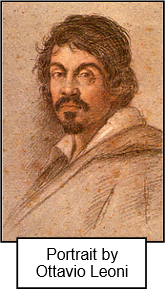 xxxxxCaravaggio, a troubled and often violent man, takes
his name from the small Lombardy hill town where he was born in
northern Italy. He was trained in the nearby city of Milan, but
was working in Rome before he was twenty. He was somewhat of a
maverick and a rebellious one at that, spending much of his life
on the move to avoid the long arm of the law. During one of the
numerous brawls in which he was involved, he killed a man and was
obliged to take flight. He went to Naples in 1606, and then
travelled on to Malta, where he completed a number of fine works.
Soon in trouble again, however, he was thrown into prison but
managed to escape to Sicily where he worked in Syracuse, Messina
and Palermo. He then returned to Naples and took a boat to Rome,
hoping to receive a pardon from the Pope. It appears that during
this voyage the boat put in at Palo and on going ashore he was
mistaken for somebody else and found himself in prison again. By
the time he was released, two days later, the boat had departed.
In desperation he began walking along the malaria-infested
coast and, catching a fever, died at Porto Ercole, a garrison town
on the border with the Papal States.
xxxxxCaravaggio, a troubled and often violent man, takes
his name from the small Lombardy hill town where he was born in
northern Italy. He was trained in the nearby city of Milan, but
was working in Rome before he was twenty. He was somewhat of a
maverick and a rebellious one at that, spending much of his life
on the move to avoid the long arm of the law. During one of the
numerous brawls in which he was involved, he killed a man and was
obliged to take flight. He went to Naples in 1606, and then
travelled on to Malta, where he completed a number of fine works.
Soon in trouble again, however, he was thrown into prison but
managed to escape to Sicily where he worked in Syracuse, Messina
and Palermo. He then returned to Naples and took a boat to Rome,
hoping to receive a pardon from the Pope. It appears that during
this voyage the boat put in at Palo and on going ashore he was
mistaken for somebody else and found himself in prison again. By
the time he was released, two days later, the boat had departed.
In desperation he began walking along the malaria-infested
coast and, catching a fever, died at Porto Ercole, a garrison town
on the border with the Papal States.
xxxxxLike his
life-style, his art was far from conventional, but it was
successful nonetheless. His work shows an exaggerated, dramatic
management of light, a skilful use of foreshortening, and a
painstaking attention to detail, but it is in the reality of his
interpretation, bordering often upon the gruesome, that Caravaggio
both shocks and shines. From an early age he saw art as of no
worth unless it portrayed life as it was - dirty fingernails
and all. Biblical personalities - hitherto afforded a dignity
befitting their religious importance - are given the
demeanour and dress of peasants. We are told that his girlfriend,
a prostitute, was a model for his painting of the Virgin Mary, and
that for the same subject he once used the bloated body of a woman
found floating in the Tiber. In fact his Death
of the Virgin was rejected by the
Carmelites because of her bared legs and distended stomach and, on
the advice of Rubens, was bought by the Duke of Mantua.
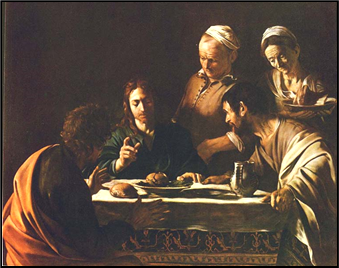 xxxxxDoubtless as a result of his turbulent and brutal
life - he would often go out looking
for a fight! - he took great delight in subjects of a
gruesome nature. His Judith Beheading
Holofernes, David with the Head
of Goliath, and the Beheading
of St. John the Baptist leave nothing to the imagination,
and his Sacrifice of Abraham and Medusa are studies of wild terror on the
faces of the victims. These were glimpses of compelling realism.
But not all his works were grisly in content. For example, his The Calling of St. Matthew, the first
version of Supper at Emmaus, and The Conversion of St. Paul, though somewhat
theatrical in style, are brilliant above all for their directed
light, the incredible regard to detail, and the expressions on the
faces. And earlier works, such as Bacchus,
The Gipsy Fortune Teller, and The
Rest on the Flight into Egypt
show a softer side to his art if not to his nature. In this
regard, his second version of the Supper at
Emmaus (illustrated), a much more subdued and moving interpretation, must
be numbered among his masterpieces.
xxxxxDoubtless as a result of his turbulent and brutal
life - he would often go out looking
for a fight! - he took great delight in subjects of a
gruesome nature. His Judith Beheading
Holofernes, David with the Head
of Goliath, and the Beheading
of St. John the Baptist leave nothing to the imagination,
and his Sacrifice of Abraham and Medusa are studies of wild terror on the
faces of the victims. These were glimpses of compelling realism.
But not all his works were grisly in content. For example, his The Calling of St. Matthew, the first
version of Supper at Emmaus, and The Conversion of St. Paul, though somewhat
theatrical in style, are brilliant above all for their directed
light, the incredible regard to detail, and the expressions on the
faces. And earlier works, such as Bacchus,
The Gipsy Fortune Teller, and The
Rest on the Flight into Egypt
show a softer side to his art if not to his nature. In this
regard, his second version of the Supper at
Emmaus (illustrated), a much more subdued and moving interpretation, must
be numbered among his masterpieces.
xxxxxHis first
years in Rome were spent in extreme poverty, but by about 1599 he
had come to the attention of Cardinal Del Monte, a well-known
music and art lover, and was working as a member of his household.
The Cardinal, it would seem, had a liking for young boys, and that
is probably the reason why some of Caravaggio's early works,
including altar pieces, depicted adolescents and comely cherubs.
It was almost certainly through his patron's good offices that he
obtained the commission to paint three large canvases depicting
the life of St. Matthew. He struggled for a while, but the
finished work brought him fame and fortune in 1599,
despite the fact that he had to redo one of them (St.
Matthew and the Angel) because the Saint's plebeian
features gave offence! From then on he was never short of orders,
but this all came to an abrupt end with his flight from the law in
1606. He spent about nine months in Naples, where he completed
three large altarpieces, including his Flagellation
of Christ, and then sailed for Malta, arriving there in
July 1607.
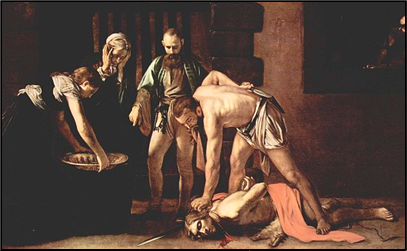 xxxxxAt first he was well received in Malta, his fame as
an artist having preceded him, and in return for portraits painted
on behalf of the Knights of Malta, including one of the
Grandmaster, he was made an honorary member. This distinction was
short-lived! His violent nature was soon revealed, and he was
expelled from the Order and stripped of all his honours. It was
while on the island of Malta that he produced for Valetta
cathedral his largest and one of his most gruesome works The
Beheading of St. John the Baptist, the Order's patron-saint
(detail illustrated).
We are told that he actually signed this painting, writing his
signature in blood. We must be generous towards him and assume that
it was his own blood! There then followed a short stay in Sicily,
living off the payments from various altarpieces, (such as the Resurrection of Lazarus and the Adoration
of the Shepherds) before his return to Naples. The story
goes that, before leaving Sicily for his fateful, uncompleted
journey to Rome, some of his enemies caught up with him and so badly
disfigured him that, from then on, he was hardly recognisable.
xxxxxAt first he was well received in Malta, his fame as
an artist having preceded him, and in return for portraits painted
on behalf of the Knights of Malta, including one of the
Grandmaster, he was made an honorary member. This distinction was
short-lived! His violent nature was soon revealed, and he was
expelled from the Order and stripped of all his honours. It was
while on the island of Malta that he produced for Valetta
cathedral his largest and one of his most gruesome works The
Beheading of St. John the Baptist, the Order's patron-saint
(detail illustrated).
We are told that he actually signed this painting, writing his
signature in blood. We must be generous towards him and assume that
it was his own blood! There then followed a short stay in Sicily,
living off the payments from various altarpieces, (such as the Resurrection of Lazarus and the Adoration
of the Shepherds) before his return to Naples. The story
goes that, before leaving Sicily for his fateful, uncompleted
journey to Rome, some of his enemies caught up with him and so badly
disfigured him that, from then on, he was hardly recognisable.
xxxxxIt is
believed that Caravaggio privately studied the works of Rubens,
Leonardo da Vinci and Michelangelo, and this would certainly have
had an effect upon his colour and composition. In his harsh use of
light - often manipulated for his own ends - he might
well have been inspired by Tintoretto. It was this extreme
contrast of light and deep shadow (hence known as tenebrism),
plus his insistence on reality - his uncompromising
"naturalism" - that were to have so marked effect upon art in
Italy and beyond. In his homeland his technique contributed to the
Baroque style then emerging, and was followed by a host of artists
known as the Caravaggisti. Further afield, his work was to
influence masters like Velazquez and Rembrandt. Shown here are
details from The Entombment, Boy
with a Basket of Fruit, and Boy
Bitten by a Lizard.
Including:
Annibale
Carracci

L1-1558-1603-L1-1558-1603-L1-1558-1603-L1-1558-1603-L1-1558-1603-L1-1558-1603-L1
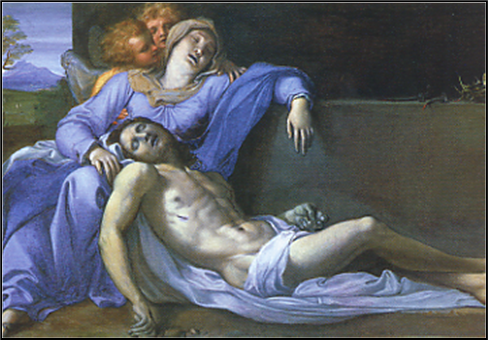 xxxxxIt was in 1595, when Caravaggio was completing his
early painting, The Gipsy Fortune Teller,
that another Italian artist, Annibale
Carracci (1560-1609), left his
native city of Bologna and began work on his masterpiece, the
interior decoration of the Farnese Palace in Rome. It was here
that a set of mythological frescoes depicting the loves of the
pagan Gods, painted on the vaulted ceiling of the Gallery, brought
him instant fame. Indeed, so well was this series received
(especially the central theme The Triumph of
Bacchus and Ariadne), that he was
regarded as a worthy successor to the Renaissance giants,
Michelangelo and Raphael. His workmanship, characterised by
powerfully modelled figures, rich colours and a pervading sense of
vigour, now became much in demand. He went on to produce a number
of fine altarpieces, and in 1601 he worked alongside Caravaggio
while painting his Assumption for the
Cerasi Chapel in Santa Maria del Popolo. Among his other religious
works were his The Dead Christ Mourned,
a highly theatrical study, and his Pietá,
a moving portrayal in which the pathos is enhanced by the soft,
cool blue of both garment and shroud (illustrated).
xxxxxIt was in 1595, when Caravaggio was completing his
early painting, The Gipsy Fortune Teller,
that another Italian artist, Annibale
Carracci (1560-1609), left his
native city of Bologna and began work on his masterpiece, the
interior decoration of the Farnese Palace in Rome. It was here
that a set of mythological frescoes depicting the loves of the
pagan Gods, painted on the vaulted ceiling of the Gallery, brought
him instant fame. Indeed, so well was this series received
(especially the central theme The Triumph of
Bacchus and Ariadne), that he was
regarded as a worthy successor to the Renaissance giants,
Michelangelo and Raphael. His workmanship, characterised by
powerfully modelled figures, rich colours and a pervading sense of
vigour, now became much in demand. He went on to produce a number
of fine altarpieces, and in 1601 he worked alongside Caravaggio
while painting his Assumption for the
Cerasi Chapel in Santa Maria del Popolo. Among his other religious
works were his The Dead Christ Mourned,
a highly theatrical study, and his Pietá,
a moving portrayal in which the pathos is enhanced by the soft,
cool blue of both garment and shroud (illustrated).
xxxxxBut apart
from his religious paintings and frescoes, he produced a number of
realistic genre scenes, such as The Butcher's
Shop and Boy Drinking (both in
Christ Church College, Oxford), and his landscapes became noted
for their classical settings, a feature which was later employed
and developed by others, including the French artists Claude
Lorrain and Nicolas Poussin. He also left a vast collection of
drawings - some two hundred are now in the Royal Library at
Windsor Castle - and many were made as preparatory pieces for
his work in the Farnese Palace.
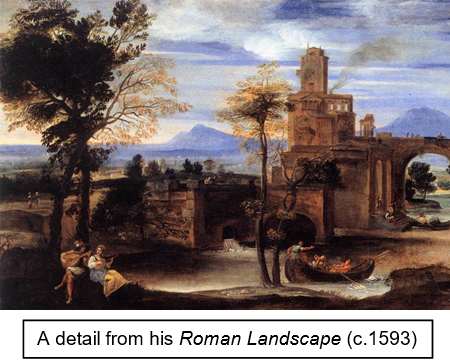 xxxxxLittle is known of his early life, but he came from
an artistic and fairly humble family. As a young artist he greatly
admired the paintings of Correggio and, while
in Venice, studying the works of Titian, he met both Tintoretto
and Veronese. He was devoted to his work as an artist, and would
seem to have been a kindly, well-meaning man, but he was
prone to fits of depression and he produced little during the last
five years of his life. He died at the age of 49 and was buried in
the Pantheon, the resting place of Raphael, the artist he so much
admired. Forxsome years he was assisted
in his work by his brother Agostino
Carracci (1557-1602). They were
both prominent members of the Bologna school of painting, founded
by their cousin Lodovicio in 1585. Under their guidance, this
school, emphasising as it did the need to draw from live models,
played an important part in bringing about the decline of
Mannerism and the development of the early Baroque style.
xxxxxLittle is known of his early life, but he came from
an artistic and fairly humble family. As a young artist he greatly
admired the paintings of Correggio and, while
in Venice, studying the works of Titian, he met both Tintoretto
and Veronese. He was devoted to his work as an artist, and would
seem to have been a kindly, well-meaning man, but he was
prone to fits of depression and he produced little during the last
five years of his life. He died at the age of 49 and was buried in
the Pantheon, the resting place of Raphael, the artist he so much
admired. Forxsome years he was assisted
in his work by his brother Agostino
Carracci (1557-1602). They were
both prominent members of the Bologna school of painting, founded
by their cousin Lodovicio in 1585. Under their guidance, this
school, emphasising as it did the need to draw from live models,
played an important part in bringing about the decline of
Mannerism and the development of the early Baroque style.
xxxxxShown here
are The Bean Eater, Decoration
in the Farnese Palace, and Satyr and
Shepherd.
xxxxxAnother
Italian artist at this time was Annibale
Carracci (1560-1609). He began his
masterpiece, the interior decoration of the Farnese Palace in
Rome, in 1595, and this won him wide acclaim. Indeed, his
mythological frescoes depicting the loves of the pagan Gods,
painted on the vaulted ceiling of the Gallery, was regarded as
comparable to the work of Michelangelo and Raphael. He painted a
number of fine altarpieces, notable for their powerful figures and
rich colours, and in 1601 he worked alongside Caravaggio while
painting his Assumption. Particularly
noteworthy among his religious works are his The
Dead Christ Mourned and his
moving Pietá, a study enhanced by his
use of a soft tone of blue. He produced a number of genre
paintings, such as The Butcher’s Shop,
and his landscapes were noted for their classical settings, seen
later in the works of Claude Lorrain and Nicolas Poussin. Some 200
of his drawings are now in the Royal Library at Windsor Castle. A
member of the Bologna school of painting, he much admired the
works of Correggio and Titian, and while in Venice met both
Tintoretto and Veronese.
xxxxxIncidentally, it is very likely that Carracci was the first
artist to produce caricatures, and that it was he who coined the
word "caricatura", from the Latin verb caricare
meaning "to overload", i.e. "exaggerate". A series of portrait
caricatures poking fun at the conceit and pretence of local
courtiers was produced at this time (illustrated) and, since he openly criticised such ostentation,
they were probably drawn by him.









 xxxxxCaravaggio, a troubled and often violent man, takes
his name from the small Lombardy hill town where he was born in
northern Italy. He was trained in the nearby city of Milan, but
was working in Rome before he was twenty. He was somewhat of a
maverick and a rebellious one at that, spending much of his life
on the move to avoid the long arm of the law. During one of the
numerous brawls in which he was involved, he killed a man and was
obliged to take flight. He went to Naples in 1606, and then
travelled on to Malta, where he completed a number of fine works.
Soon in trouble again, however, he was thrown into prison but
managed to escape to Sicily where he worked in Syracuse, Messina
and Palermo. He then returned to Naples and took a boat to Rome,
hoping to receive a pardon from the Pope. It appears that during
this voyage the boat put in at Palo and on going ashore he was
mistaken for somebody else and found himself in prison again. By
the time he was released, two days later, the boat had departed.
In desperation he began walking along the malaria-
xxxxxCaravaggio, a troubled and often violent man, takes
his name from the small Lombardy hill town where he was born in
northern Italy. He was trained in the nearby city of Milan, but
was working in Rome before he was twenty. He was somewhat of a
maverick and a rebellious one at that, spending much of his life
on the move to avoid the long arm of the law. During one of the
numerous brawls in which he was involved, he killed a man and was
obliged to take flight. He went to Naples in 1606, and then
travelled on to Malta, where he completed a number of fine works.
Soon in trouble again, however, he was thrown into prison but
managed to escape to Sicily where he worked in Syracuse, Messina
and Palermo. He then returned to Naples and took a boat to Rome,
hoping to receive a pardon from the Pope. It appears that during
this voyage the boat put in at Palo and on going ashore he was
mistaken for somebody else and found himself in prison again. By
the time he was released, two days later, the boat had departed.
In desperation he began walking along the malaria- xxxxxDoubtless as a result of his turbulent and brutal
life -
xxxxxDoubtless as a result of his turbulent and brutal
life - xxxxxAt first he was well received in Malta, his fame as
an artist having preceded him, and in return for portraits painted
on behalf of the Knights of Malta, including one of the
Grandmaster, he was made an honorary member. This distinction was
short-
xxxxxAt first he was well received in Malta, his fame as
an artist having preceded him, and in return for portraits painted
on behalf of the Knights of Malta, including one of the
Grandmaster, he was made an honorary member. This distinction was
short-
 xxxxxIt was in 1595, when Caravaggio was completing his
early painting, The Gipsy Fortune Teller,
that another Italian artist, Annibale
Carracci (1560-
xxxxxIt was in 1595, when Caravaggio was completing his
early painting, The Gipsy Fortune Teller,
that another Italian artist, Annibale
Carracci (1560- xxxxxLittle is known of his early life, but he came from
an artistic and fairly humble family. As a young artist he greatly
admired the paintings of Correggio and, while
in Venice, studying the works of Titian, he met both Tintoretto
and Veronese. He was devoted to his work as an artist, and would
seem to have been a kindly, well-
xxxxxLittle is known of his early life, but he came from
an artistic and fairly humble family. As a young artist he greatly
admired the paintings of Correggio and, while
in Venice, studying the works of Titian, he met both Tintoretto
and Veronese. He was devoted to his work as an artist, and would
seem to have been a kindly, well-




